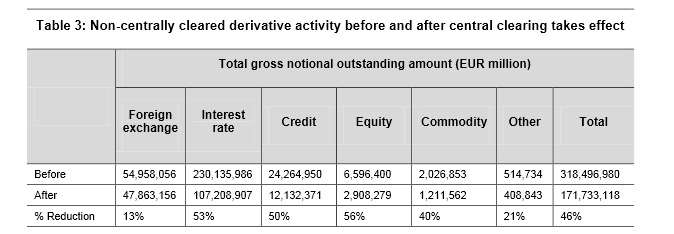 The Basel Committee on Banking Supervision and the International Organization of Securities Commissions have jointly issued a second consultative paper that they are calling their “near-final proposal” on margin requirements for non-centrally cleared derivatives. Welcome to the first half of AllAboutAlpha’s two-part discussion of the salient points in the paper. Basel/IOSCO (to whom I will refer as a single entity hereafter) is soliciting feedback on four issues: the treatment of physically-settled foreign exchange forwards and swaps; the ability to engage in limited re-hypothecation of collected initial margin; the proposed phase-in of the margin requirements; and the adequacy of a quantitative impact study conducted last year. This is a fairly narrow selection of the issues on which they presumably could seek feedback, but then, that is what it means to say that they are at a “near final” stage in their deliberations. This entry will focus on forex, rehypothecation, and the materials surrounding both. I’ll reserve the phase-in and the QIS for another day. In the Works since 2009 The Group of 20 reform program, agreed upon in 2009, included four elements: all standardized over-the-counter derivatives should be traded on exchanges or electronic platforms, where appropriate; all standardized OTC derivatives should be cleared through central counterparties; OTC derivatives contracts should be reported to trade repositories; and derivatives not cleared through a CCP should be subjected to higher capital requirements than those that are. In 2011, the G20 added margin requirements for non-centrally cleared derivatives to its desiderata, and it asked Basel and IOSCO to develop consistent global standards for such requirements. Capital requirements and margin requirements are distinct approaches to the same end, preserving the financial system against the threat of a line of falling dominoes: shoring up as many dominoes as possible so in the next great crisis a significant number of them will survive the fall of their neighbors. They are distinct approaches, of course. Capital requirements allow a survivor to accept its losses. Margin allows it to recover from the failed neighbor. This brings us to the first of the four open issues. Basel/IOSCO isn’t certain whether margin requirements should apply to physically settled FX forwards and swaps. In a separate document, “supervisory guidance for managing risks associated with the settlement of foreign exchange transactions,” it acknowledges that the FX market “has made significant strides in reducing the risks associated with the settlement of FX transactions” in recent years. So perhaps margin requirements are unnecessary and given the peculiarities of that market, uniquely burdensome? They are inviting participants to make that case.
The Basel Committee on Banking Supervision and the International Organization of Securities Commissions have jointly issued a second consultative paper that they are calling their “near-final proposal” on margin requirements for non-centrally cleared derivatives. Welcome to the first half of AllAboutAlpha’s two-part discussion of the salient points in the paper. Basel/IOSCO (to whom I will refer as a single entity hereafter) is soliciting feedback on four issues: the treatment of physically-settled foreign exchange forwards and swaps; the ability to engage in limited re-hypothecation of collected initial margin; the proposed phase-in of the margin requirements; and the adequacy of a quantitative impact study conducted last year. This is a fairly narrow selection of the issues on which they presumably could seek feedback, but then, that is what it means to say that they are at a “near final” stage in their deliberations. This entry will focus on forex, rehypothecation, and the materials surrounding both. I’ll reserve the phase-in and the QIS for another day. In the Works since 2009 The Group of 20 reform program, agreed upon in 2009, included four elements: all standardized over-the-counter derivatives should be traded on exchanges or electronic platforms, where appropriate; all standardized OTC derivatives should be cleared through central counterparties; OTC derivatives contracts should be reported to trade repositories; and derivatives not cleared through a CCP should be subjected to higher capital requirements than those that are. In 2011, the G20 added margin requirements for non-centrally cleared derivatives to its desiderata, and it asked Basel and IOSCO to develop consistent global standards for such requirements. Capital requirements and margin requirements are distinct approaches to the same end, preserving the financial system against the threat of a line of falling dominoes: shoring up as many dominoes as possible so in the next great crisis a significant number of them will survive the fall of their neighbors. They are distinct approaches, of course. Capital requirements allow a survivor to accept its losses. Margin allows it to recover from the failed neighbor. This brings us to the first of the four open issues. Basel/IOSCO isn’t certain whether margin requirements should apply to physically settled FX forwards and swaps. In a separate document, “supervisory guidance for managing risks associated with the settlement of foreign exchange transactions,” it acknowledges that the FX market “has made significant strides in reducing the risks associated with the settlement of FX transactions” in recent years. So perhaps margin requirements are unnecessary and given the peculiarities of that market, uniquely burdensome? They are inviting participants to make that case.  The above table indicates one datum that may be important to those who want to make that case. Basel/IOSCO expects that the reduction in non-centrally cleared activity after the central clearing mandates take effect will be relatively small in the FX market. In terms of the gross notional amounts across all QIS respondents, the reduction for FX will be 13 percent, in contrast to, say, 56 percent in the equity derivatives markets and 50 percent in credit derivatives. Operational Challenges It is a key principle, perhaps even the key principle, of the proposal that all covered entities must exchange initial and variation margin appropriate to the counterparty risks posed by their transactions, initial margin not to exceed €50 million, and with a de minimis minimum transfer amount not to exceed €100,000. The required initial margin is to be computed by reference to a standardized margin set out in the report’s Appendix A adjusted by an amount relating to the net-to-gross ratio (NGR). The definition of the NGR comes from the fine print of the Basel II framework. Specifically, the net-to-gross ratio (NGR) is defined in Annex 4 of Basel II, paragraph 96(iv) as the level of net replacement cost to level of gross replacement cost for transactions subject to legally enforceable netting agreements. Rehypothecation Once the amount of the initial margin is settled and transferred: what then? What are the rules for how it may be used? There is a risk that the margin won’t serve its intended purpose “if the counterparty re-hypothecates or re-uses the provided margin, which could result in third parties having legal or beneficial title….” This brings us to the second open question: “Should re-hypothecation be allowed to finance/hedge customer positions…?” Basel/IOSCO notes that if such re-hypothecation is allowed at all, it will only be under strict conditions, and the paper lists three plausible conditions:
The above table indicates one datum that may be important to those who want to make that case. Basel/IOSCO expects that the reduction in non-centrally cleared activity after the central clearing mandates take effect will be relatively small in the FX market. In terms of the gross notional amounts across all QIS respondents, the reduction for FX will be 13 percent, in contrast to, say, 56 percent in the equity derivatives markets and 50 percent in credit derivatives. Operational Challenges It is a key principle, perhaps even the key principle, of the proposal that all covered entities must exchange initial and variation margin appropriate to the counterparty risks posed by their transactions, initial margin not to exceed €50 million, and with a de minimis minimum transfer amount not to exceed €100,000. The required initial margin is to be computed by reference to a standardized margin set out in the report’s Appendix A adjusted by an amount relating to the net-to-gross ratio (NGR). The definition of the NGR comes from the fine print of the Basel II framework. Specifically, the net-to-gross ratio (NGR) is defined in Annex 4 of Basel II, paragraph 96(iv) as the level of net replacement cost to level of gross replacement cost for transactions subject to legally enforceable netting agreements. Rehypothecation Once the amount of the initial margin is settled and transferred: what then? What are the rules for how it may be used? There is a risk that the margin won’t serve its intended purpose “if the counterparty re-hypothecates or re-uses the provided margin, which could result in third parties having legal or beneficial title….” This brings us to the second open question: “Should re-hypothecation be allowed to finance/hedge customer positions…?” Basel/IOSCO notes that if such re-hypothecation is allowed at all, it will only be under strict conditions, and the paper lists three plausible conditions:
- That the collateral can only be re-hypothecated to finance or hedge a customer, non-proprietary position;
- That the pledgee treats the re-hypothecated collateral as customer assets; and that
- The applicable insolvency regime allows customer first priority claim over the pledged collateral.
Parties who want to make the case that rehypothecation ought to be permitted might start from a working paper issued by the IMF more than a year ago now, that described re-hypothecation and other sorts of collateral re-use as a vital lubricant to the bank/non-bank nexus, strongly suggesting it would be follow to withdraw said lubricant.



